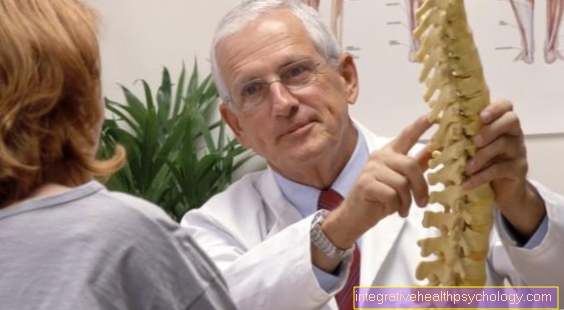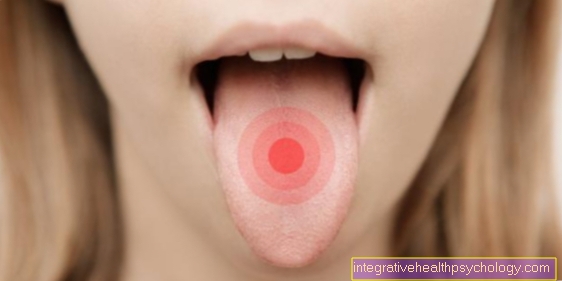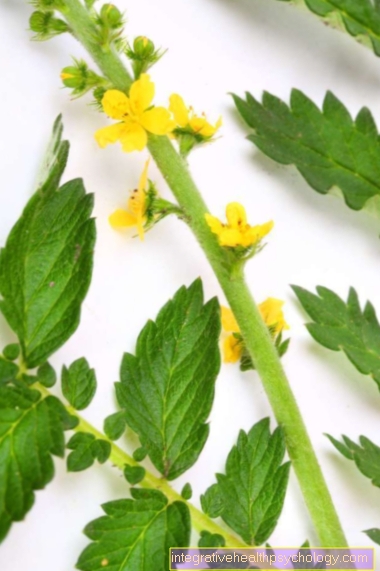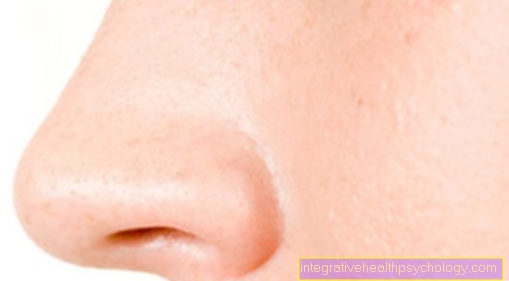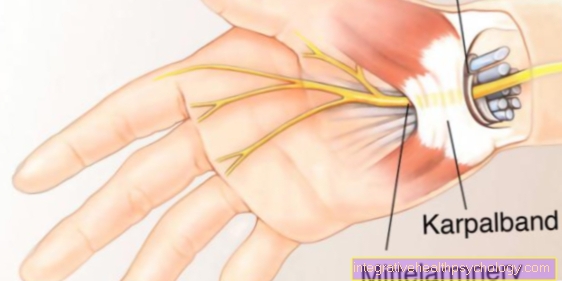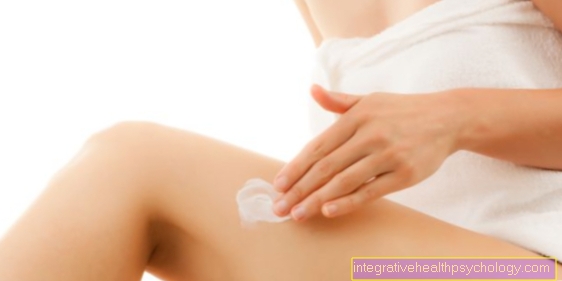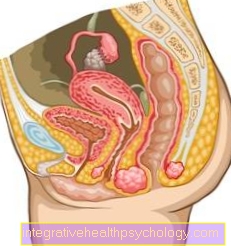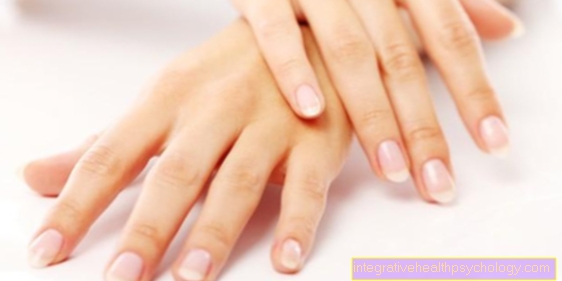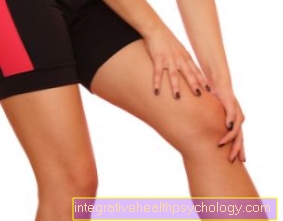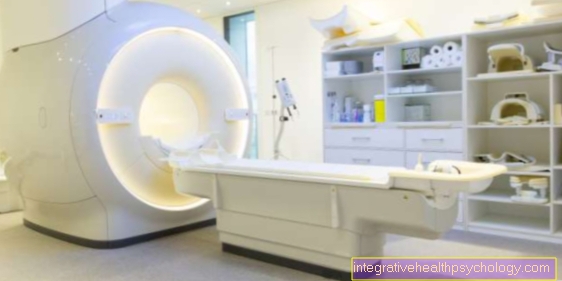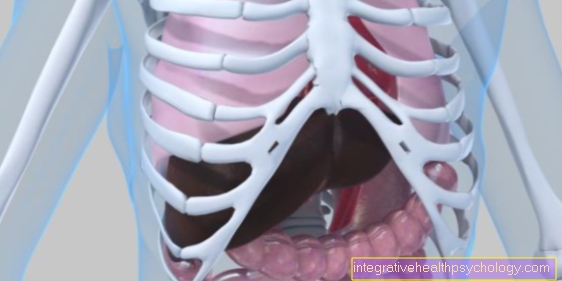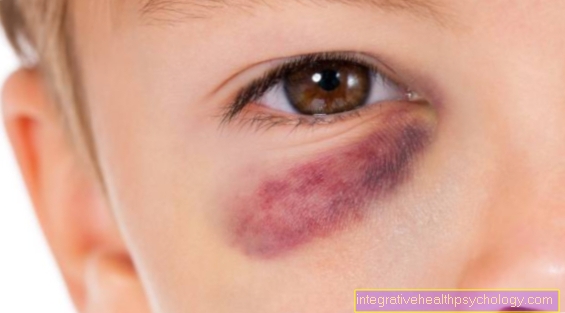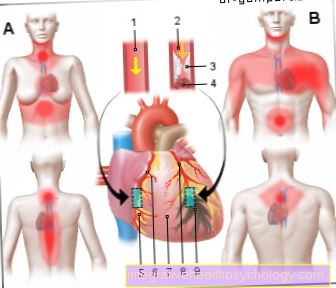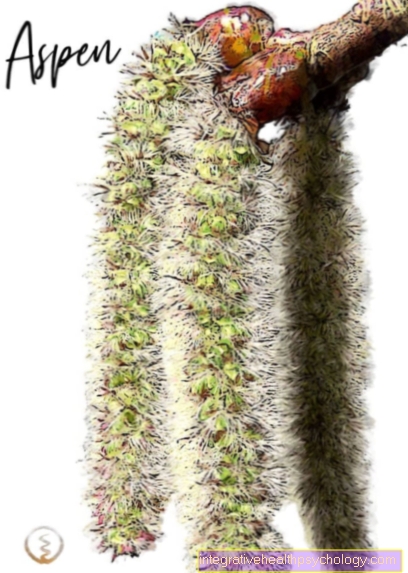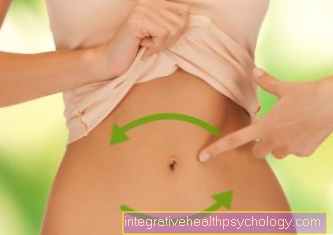The skin seam
introduction
Skin sutures are performed for lacerations or cuts, after operations or in the case of other deeper injuries. The aim of a good skin suture is to optimally adapt the wound edges so that the wound heals without scars and complications (see also: Wound healing). Skin sutures can be performed using different suturing techniques and with different materials.

Sutures
In general, this never applies to any type of skin seam Hands directly guide the needle, but this is clamped in a clamp. The Wound edges are held with surgical forceps. This also serves that Re-tensioning the needlewhen the stitch direction changes. Basically, every suture must sterile, tear and knot-proof, tissue-friendly and manipulable be.
These requirements apply to all sutures, regardless of whether they are used for the skin or organs is being used.
First, sutures can be in absorbable and non-absorbable material distinguish.
Absorbable sutures
The property of absorbable suture material is that it dissolves itself after a certain time and therefore does not have to be removed manually. This has the advantage that no further manipulation is necessary. It also enables seams in organs, muscles or deep in the skin. So it is used in places that need to be adapted temporarily. However, the tear resistance of the material slowly decreases after a relatively short time, so that the fabric itself then has to apply the tear resistance. For example, polyglycolic acid threads only have 50% of their original tear strength after approx. 15 days. After about 3 months, the threads are completely absorbed.
Non-absorbable sutures
Non-absorbable sutures are used in places with increased mechanical stress. This guarantees permanent support for the strength of the tissue. A distinction is made between two different substances.
On the one hand the plastic polymers, which are monofilament (not braided) or polyfil (braided) could be. The plastic polymers have the advantage that they have good knot strength, a low foreign body reaction and a low risk of infection. However, there is a risk of an allergic reaction. In such a case, the threads must be removed again.
Silk is the second material of the non-absorbable thread. However, since these involve a high risk of infection, they are only used today for temporary sutures. However, they are very flexible and have good knotting properties, but are not very elastic.
Thread size
The thread size denotes the diameter of surgical sutures. There are different measuring systems for the thread size, namely that American USP system (United States Pharmacopeia) and that European EP system (European Pharmacopoeia, "Metric System"). The strength of the thread describes the thickness and, together with the material properties, determines the tear resistance.
The thread size is in the form of numbers based on the number 0 specified. The thread of strength 12-0 is the thinnest thread and is used in the Microsurgery applied. He is approx. 0,001-0,009 mm thick. The widest thread carries the thread size 7, is approx. 0,9 mm thick and is used for joint stabilization. Skin sutures are usually made with a 2-0 or 3-0 Thread sewn. These are approx. 0.2 to 0.3 mm thick.
In principle you try to be a the thinnest possible suture material to be used to perform a wound closure. However, the thread must be thick enough to achieve a sufficiently strong wound closure. You basically try that optimal compromise to be found between tear resistance and the least possible tissue damage.
The choice of thread is left to an experienced surgeon and places one on the wound individually tailored decision In principle, threads with a larger diameter are used for wounds that are subject to greater tensile and shear forces. A thinner diameter can be chosen if the wound is not exposed to great stress.
Needle-thread combination
In addition to the thread thickness, the Needle-thread combination can be distinguished. Here one differentiates traumatic and atraumatic suturing.
At the traumatic sewing the thread must be threaded into the needle, similar to sewing fabric. The advantage is that the Needle used again and the needle and thread can be freely combined. Also, this variant is cheaper. However, one will greater trauma to the tissue and another work step is necessary. For this reason, traumatic suturing is only used when the appropriate needle-thread combination is not available.
At the atraumatic suturing the thread emerges directly from the needle. I.e. the thread must no longer threaded and causes less tissue trauma. However, the costs are higher here, and the needle-thread combination is predetermined and cannot be freely selected. The atraumatic suturing will almost always usedif the appropriate combination is available. In addition, for very sensitive tissue, such as sewing the peritoneum (peritoneum).
Sewing machines

To a Skin seam to be carried out either:
- Staplers
- Adhesives or
- monofilament plastic threads utilized.
Squeeze the staplers Stainless steel brackets into the tissue and bend it so that the clamps are closed and cannot easily be removed. There are different staplers that make different seams depending on your requirements. To the Skin closure single staplers are used. Advantage of these staplers is one very quick closure of the wounds and fine scars. The brackets are after approx. 10 days removed again with the help of a special device. This device bends the clamps open again and removes them completely painlessly.
It can also be used to close the skin / skin seam Glue used become. There are different ones for this Fibrin glue and Butyl cyanoacrylate. This is available in ampoules or as a spray. With the help of humidity and polymerization, small skin wounds on the face can be closed. The adhesive burns on the fresh wound for a short time, but then it is no longer noticeable or visible and is absorbed after a certain time. Stay back narrow scarsthat are barely visible.
Plus there are those Possibility of adhesive tape (Steristrip). These are used on smaller skin wounds and make a very good cosmetic result. However, the wound edge adaptation of this skin suture is not guaranteed as well as with staples or sutures, so that the wounds not so deep be allowed to achieve a good result.
In general, that deeper and bigger wounds always with the help of Seams or staples must be closed, otherwise the adaptation of the wound edges cannot be guaranteed. Small, superficial cuts however, can be done quickly and painlessly Glue or tape close. Another advantage of these measures is that no local anesthesia is necessary, whereas local anesthesia of the wound and its surroundings is always necessary before suturing or stapling.
Knot technique
Following each Skin seam the threads must be knotted. To a optimal strength of the knot will always be reached three knots made, whereby these should be in opposite directions. Basically, the first knot should fix the wound in the intended position, while the second counter-rotating knot should stabilize the first knot. To be on the safe side, a third knot is made. This is a prerequisite for a well-fitting knot Tear strength of the knot. For thin and smooth (monofilament) Threads, more knots are often necessary to prevent the knot from opening on its own. A knot should always close to the wound but not pulled too tightly to avoid constrictions.
In the case of skin sutures, the knot is cut straight through with a needle and thread Looping around the thread end reached. Here, too, should be wrapped around alternately clockwise and counterclockwise take place, a total of three times. Lower nodes are created by the Index or middle finger knot attached. The special thing about this type of knot is that it can be tied with just one hand. If the knots were to be tied with both hands as when tying shoes, the would have to be surgeon have both hands available for this and hold both sutures under constant tension in order to firmly adapt the wound edges. Through the One-handed technique it is possible to keep only one thread under tension while the other thread is tied around the tight thread. This enables better control of the knot, its placement and tension.
Seam technique
The Adaptation of the wound edges can with the Skin seam can be achieved by the technique of single button or continuous seams. In addition, so-called Backstitch seams for better adaptation. Also the skin stitching technique Intracutaneous sutures are used to heal deeper wounds.
Single button seam
The single button seams offer good mechanical stability and can also be used over joints. In addition, a lot of subcutaneous tissue is not required to achieve a good cosmetic result. With this suture, the needle is stabbed in and pulled to the other side. Then the needle is stuck to the surface again and the thread is knotted.
The wound creates a U-shape. The suture should be repeated approx. 3 mm apart until the wound edges are well adapted over the entire wound surface. Since this type of suture takes a certain amount of time, this skin suturing technique is often only used for small skin wounds.
Skin seam according to Donati
The Donati skin suture is a modified form of the single button suture. The Donati skin suture is a special suture technique in which the skin is pricked a total of 4 times. The first puncture is made at a slightly greater distance from the wound edge than with a single button suture. On the opposite side, the first cut is made at the same distance as the cut. The backstitch is now carried out, unlike a single button seam. The puncture is made as close as possible to the edge of the wound and somewhat more superficial than the previous stitches. On the opposite side, the second incision is also made as close to the wound as possible. After the second puncture, the wound can now be closed with a knot. The Donati backstitch seam is used for wounds that are subject to high tensile or shear forces. This is the case, for example, in the area of the joints, the back or occasionally on the stomach.
It offers the advantage that it leads to a particularly firm wound closure and can bring the wound edges together very precisely. This promotes good healing and a suitable growth of the wound edges. However, the Donati suture is not always suitable for cosmetically optimal results, as it is pierced a total of 4 times. With very thick sutures, small scars in the form of white dots may remain at the points of the punctures. Therefore, the Donati suture is not necessarily suitable for wounds in the face area.
Skin seam according to Algöwer
The Algöwer skin seam is a backstitch seam that is a modification of the Donati skin seam. It consists of a total of three stitches. The puncture is made on one side of the wound and goes through the fatty tissue under the skin. There is a so-called backstitch on the opposite side. It is inserted into the fatty tissue under the skin and then punched out again in a U-shaped movement so that the needle does not come out of the skin again. The last stitch is done on the opposite side, where the first stitch already took place. Then the seam is knotted.
The advantage of this suture is that the epidermis is only penetrated twice and not four times, as with the Donati suture. This can result in a maximum of two punctiform scars. The cosmetic result is therefore potentially better than with the Donati seam.
The disadvantage, however, is that this seam does not have the same strength as the Donati seam. It is therefore not suitable for wounds that are exposed to strong tensile or shear forces. For skin areas that are, however, very visible, the seam is preferable because of its cosmetic superiority.
Continuous seam technique
In contrast to the single button seams, there are still those Continuous intracutaneous suturing technique. A continuous seam is a seam technique in which the Seam not interrupted by knots becomes. It is practically carried out “in one piece” and is only knotted after the last stitches. There are several wounds that use continuous sutures. Often will Wounds in the depths continuously sewn for additional stability. A suture is then made superficially for secure wound closure.
An example of a continuous seam is that Intracutaneous suturein which the thread runs just below the surface of the skin. A puncture is only made at the end of the wound. Thus there are only two insertion and removal channels. The skin surface is only injured at the beginning and the end of the seam. Unlike with non-continuous seams, you can not so many punctiform scars caused by the incisions and recesses. Intracutaneous sutures are suitable for tension-free woundsthat do not have large tensile or shear forces on the wound. Especially when cosmetically flawless results are required, a continuous seam is preferred. With this technique, there is usually only one skin suture very narrow, fine scar back. However, it must always be decided in each individual case which suture offers the safest wound closure and which is possible in the individual situation.
The thread should be tightened regularly in order to achieve good wound adaptation. tension should be on the skin be avoided. This shape of the seam is mainly used with larger wounds in obvious places used because the scar becomes very narrow and is hardly visible.
Summary
thanks to the good advancement Sutures and sutures and knots are the most injuries today well lockable and hardly leave any scars. Here is one good wound care and cleaning essential before closing the wound edges. Also should Sutures and Seam technique should be chosen carefully to avoid complications as much as possible.
Thanks to the large selection of different threads, needles and suturing techniques, the optimal care Find. In addition, nowadays it is no longer just possible to sew wounds, but to close them with the help of clips, adhesives or adhesive strips. However, it has been shown that the Scar healing is very individual runs and thus scarring can hardly be avoided. But nowadays it is possible to do this with the help of plastic surgery to make cosmetically beautiful.
Infections, increased resilience and mechanical stress should be avoided in any case, or infections should be treated as early as possible to avoid complications. Basically, every scar active for about 1 year after the injury is. The final scar condition is only visible after the past year and only then should the scar be embellished by plastic surgery, if necessary.


